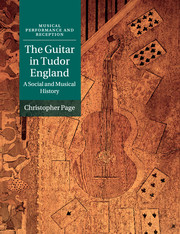Book contents
- Frontmatter
- Dedication
- Contents
- List of figures
- List of tables
- List of music examples
- Acknowledgments
- Note on music examples
- List of abbreviations
- Introduction
- 1 Imagery
- 2 Who owned a gittern?
- 3 The gittern trade
- 4 ‘An instruction to the Gitterne’
- 5 Sounding strings
- 6 The gittern and Tudor song
- 7 Thomas Whythorne: the autobiography of a Tudor guitarist
- Conclusion
- Appendix A The terms ‘gittern’ and ‘cittern’
- Appendix B References to gitterns from 1542 to 1605
- Appendix C The probate inventory of Dennys Bucke (1584)
- Appendix D Octave strings on the fourth and third course
- Appendix E The fiddle tunings of Jerome of Moravia, swept strings and the guitar
- Appendix F The mandore and the wire-strung gittern
- Appendix G The ethos of the guitar in sixteenth-century France
- Appendix H Raphe Bowle
- Bibliography
- Index
1 - Imagery
Published online by Cambridge University Press: 05 June 2016
- Frontmatter
- Dedication
- Contents
- List of figures
- List of tables
- List of music examples
- Acknowledgments
- Note on music examples
- List of abbreviations
- Introduction
- 1 Imagery
- 2 Who owned a gittern?
- 3 The gittern trade
- 4 ‘An instruction to the Gitterne’
- 5 Sounding strings
- 6 The gittern and Tudor song
- 7 Thomas Whythorne: the autobiography of a Tudor guitarist
- Conclusion
- Appendix A The terms ‘gittern’ and ‘cittern’
- Appendix B References to gitterns from 1542 to 1605
- Appendix C The probate inventory of Dennys Bucke (1584)
- Appendix D Octave strings on the fourth and third course
- Appendix E The fiddle tunings of Jerome of Moravia, swept strings and the guitar
- Appendix F The mandore and the wire-strung gittern
- Appendix G The ethos of the guitar in sixteenth-century France
- Appendix H Raphe Bowle
- Bibliography
- Index
Summary
Depictions of musical instruments on the walls, ceilings and stairways of Elizabethan houses, as they survive today, are considerably less common than the ghosts who are reputed to haunt the rooms. No doubt those unhappy spirits are grieving for the destruction of their former homes. Many houses built during the 1500s passed to descendants of the original owners, or to purchasers, who decided that the Tudor fixtures had ‘outstood their time’ and should be removed. The history of many domestic buildings after the death of Elizabeth in 1603 is therefore a sorry tale of destruction by those who had only a qualified regard for architecture deemed to be ‘Elizabethan’, a term rarely used until the later 1700s. To an eye of the eighteenth century, accustomed to landscaped gardens, Tudor-period mansions gave scant attention to the beauty of landscape ‘which was then but little or not at all regarded’, while their external plasterwork looked poor beside stucco. In an age of floor carpets, they were apt to seem draughty and inhospitable. If funds allowed, whatever was deemed to be antiquated or useless was demolished and replaced with new, or rebuilt, in a contemporary taste that better expressed the prosperity and influence of the new owner; wainscoting was taken down and sold off, wall paintings covered over and panelling removed or covered with painted paper.
This work could be very thoroughly done. It was the proud boast of Sir Richard Worsley in 1720 that he had left ‘not … one stone standing’ of the Elizabethan house he had inherited at Appuldurcombe, on the Isle of Wight (Figure 10). Even when there was no such thorough demolition, a house could suffer much from the vicissitudes of dynastic fortunes. When a member of the gentry or nobility acquired another estate by marriage, a house might fall into disrepair as their centre of political and paternalistic influence shifted to a different region of the country. Eventually, the furnishings of the neglected house might be dispersed and the building itself left to decay.
- Type
- Chapter
- Information
- The Guitar in Tudor EnglandA Social and Musical History, pp. 11 - 30Publisher: Cambridge University PressPrint publication year: 2015



